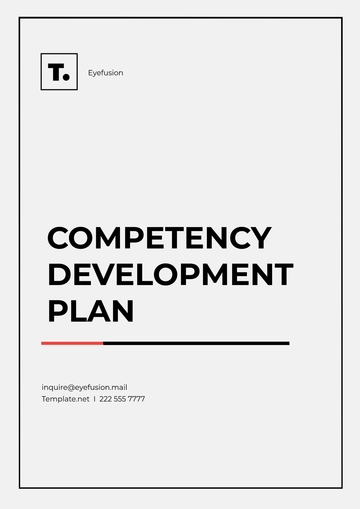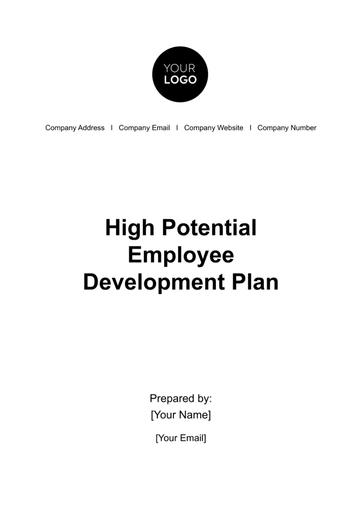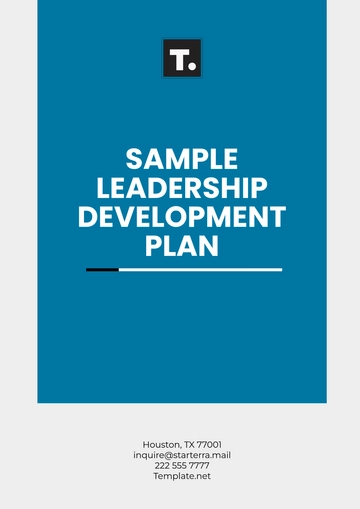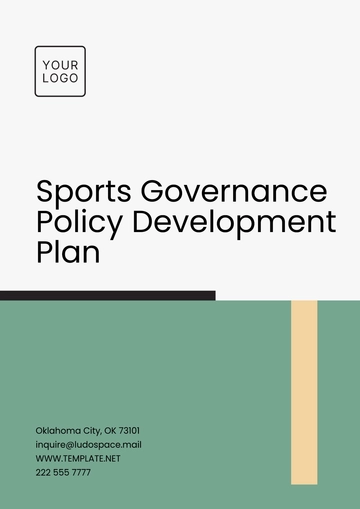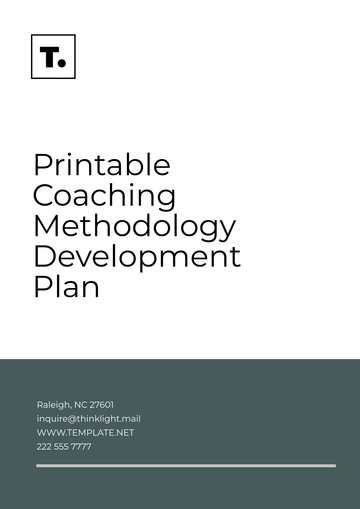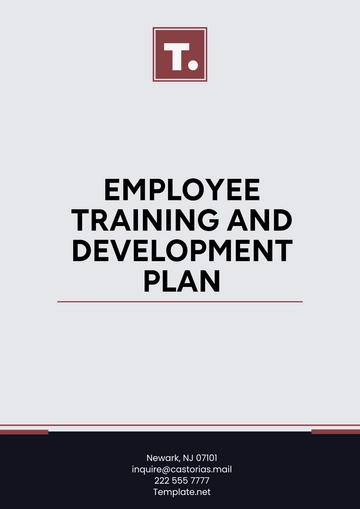Free Legal Corporate Development Plan
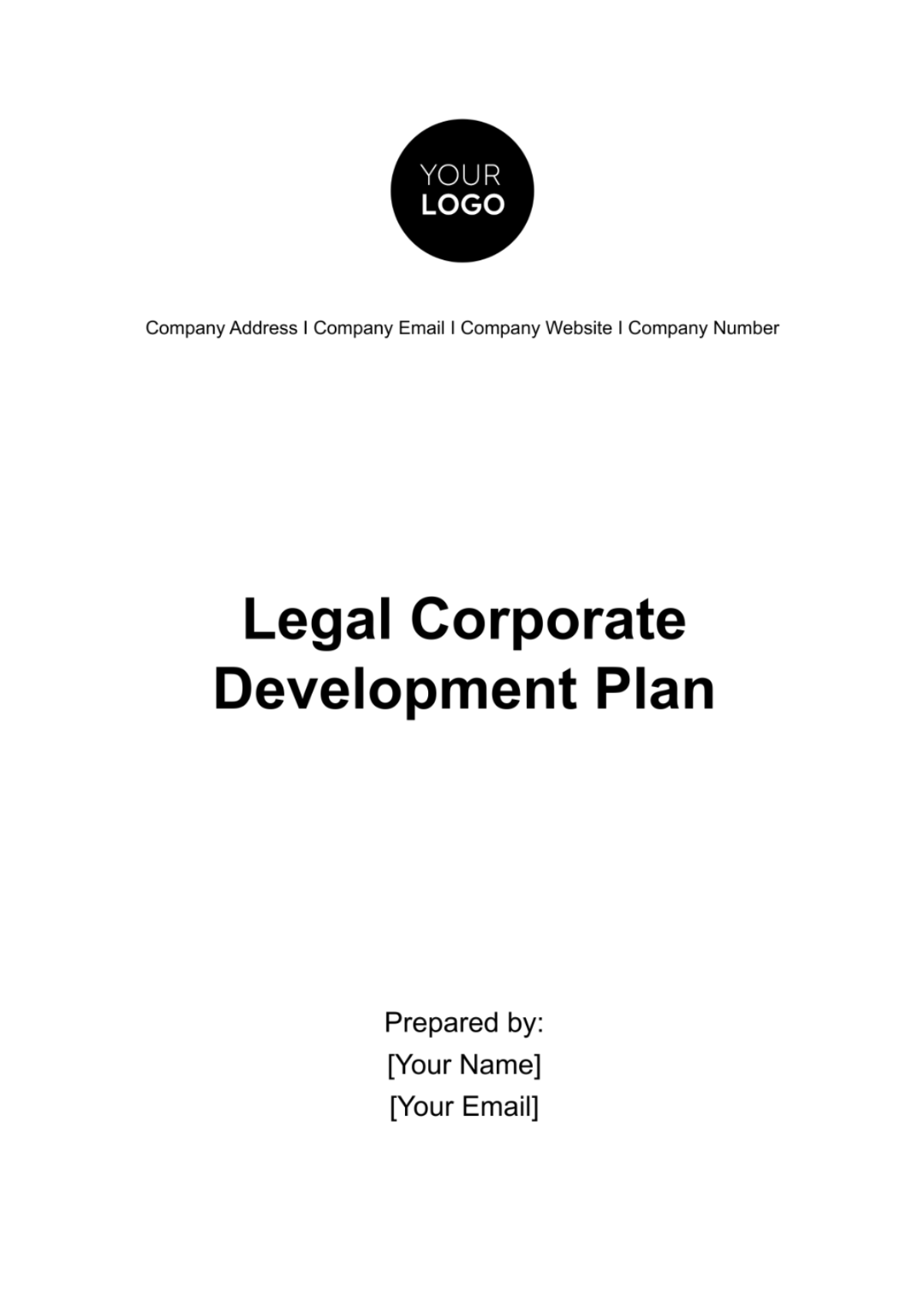
I. Overview and Objectives
A. Overview
Through its detailed and methodical structure, this Legal Corporate Development Plan is designed to facilitate the necessary legal changes for the organization's continuous growth. This plan carries a strategic and comprehensive layout, emphasizing on commencing the much-needed corporate legal developments, aiming at the sustainability and enhancement of the organization. Its core goal is to streamline and guide the systematic progression of our corporate legal actions that are pivotal for ensuring long-term growth and stability of the organization.
B. Objectives
The primary objectives of this plan are to:
Develop Legal Frameworks
We aim to develop legal frameworks that are in compliance with all relevant laws and regulations. This ensures that our corporation operates within the boundaries of the law, thereby avoiding potential legal issues.
Minimize Legal Risks and Liabilities
By proactively identifying and addressing legal risks, we can minimize potential liabilities. This proactive approach helps us prevent legal issues before they arise.
Stay Ahead of Legal Trends
We strive to stay ahead of legal trends that may affect the corporation. By doing so, we can anticipate changes and adapt our strategies accordingly.
Provide Sound Legal Advice
Our goal is to provide sound legal advice for decision-making processes. This ensures that our decisions are not only strategic but also legally sound.
Protect the Corporation’s Reputation and Brand Identity
We aim to protect the corporation’s reputation and brand identity. By managing legal risks effectively, we can prevent damage to our reputation and maintain our brand’s integrity.
II. Legal Compliance
A. Regular Compliance Audits
Conducting Regular Audits: Regular audits are conducted to assess our compliance with the relevant laws and regulations. These audits involve a thorough examination of our operations, policies, and procedures to ensure they align with the legal requirements.
Identifying Areas of Non-Compliance: During these audits, any areas of non-compliance are identified. This involves pinpointing any practices, policies, or operations that do not meet the legal standards.
Developing Action Plans: Once areas of non-compliance are identified, action plans are developed to address them. These plans outline the steps we need to take to rectify the non-compliance and ensure future compliance.
Implementing Action Plans: We then implement these action plans to ensure future compliance. This involves making the necessary changes to our operations, policies, or procedures to meet the legal requirements.
B. Training Programs
Developing and Updating Training Programs: We will develop and update training programs to educate our employees about their legal responsibilities and the importance of compliance. These programs will cover the relevant laws and regulations, our internal policies, and the consequences of non-compliance.
Regularly Reviewing Programs: We will regularly review these programs to ensure they reflect the current laws and regulations. This involves updating the content of the programs as laws and regulations change and ensuring that our employees are always equipped with the most current and relevant legal knowledge.
C. Risk Assessment Framework
Creating a Risk Assessment Framework: We will create a risk assessment framework to identify potential legal risks. This framework will outline the potential legal risks associated with our operations and provide guidelines for assessing these risks.
Regularly Updating the Framework: We will regularly update this framework to reflect changes in our operations and the legal landscape. This involves incorporating new legal risks as they arise and updating our risk assessment guidelines as necessary.
Using the Framework to Develop Strategies: We will use this framework to develop strategies to mitigate identified risks. This involves designing and implementing measures to reduce the likelihood and impact of the identified legal risks.
Implementing Risk Mitigation Strategies: We will implement these risk mitigation strategies effectively to minimize legal risks. This involves integrating these strategies into our operations and monitoring their effectiveness.
Regularly Reviewing the Effectiveness of Strategies: We will regularly review the effectiveness of these strategies and make necessary adjustments. This involves assessing whether the strategies are reducing the identified risks and making changes as necessary.
D. Response Strategies
Developing Effective Response Strategies: We will develop effective response strategies for potential violations of laws or regulations. These strategies will outline the steps to be taken in the event of a violation, ensuring a swift and effective response.
Communicating Strategies to Relevant Parties: Our response strategies will be communicated to all relevant parties. This ensures that everyone is aware of the steps to be taken in the event of a violation and can respond effectively.
E. Risk Reporting
Provide Periodic Risk Reports: We will provide periodic risk reports to senior management. These reports will highlight any potential legal risks and the steps taken to mitigate them. This ensures that senior management is always aware of the legal risks facing the corporation and can make informed decisions accordingly.
Highlight Potential Legal Risks: Our risk reports will highlight any potential legal risks identified through our audits and risk assessments. This ensures that senior management is always aware of the legal risks facing the corporation and can make informed decisions accordingly.
III. Contract Management
A. Development of a Standardized Contract
Creating a Standardized Template: We will develop a standardized contract template to be used across all business dealings. This template will include all necessary legal protections and will be compliant with all relevant laws and regulations.
Ensuring Consistency: The standardized contract will ensure consistency across all our contracts, streamline the contract creation process, and reduce the risk of oversight or errors.
Review: The standardized contract template will be regularly reviewed and updated to ensure it remains current and continues to serve its purpose effectively.
Training on the Use: We will provide training to all relevant staff on how to use the standardized contract template. This will ensure that the template is used correctly and consistently.
Monitoring the Use: We will monitor the use of the standardized contract template to ensure it is being used appropriately and effectively.
Gathering Feedback: We will gather feedback on the use of the standardized contract template and make improvements as necessary.
B. Implementation of a Contract Management System
System Selection: We will select a contract management system that best fits our needs in terms of functionality, ease of use, and cost-effectiveness.
System Implementation: We will implement the selected system, ensuring it is properly integrated with our existing processes and systems.
Training on the Use of the System: We will provide training to all relevant staff on how to use the contract management system effectively.
Monitoring and Improving the System: We will continuously monitor the use of the system and make improvements as necessary to ensure it continues to meet our needs.
C. Periodic Review of Contracts
Regular Reviews: We will conduct regular reviews of our contracts to ensure they remain beneficial and legally sound.
Amendment of Contracts: If any issues or potential improvements are identified during the reviews, we will amend the contracts accordingly.
Monitoring Contract Performance: We will monitor the performance of our contracts to ensure they are delivering the expected benefits.
Gathering Feedback: We will gather feedback from contract parties and other stakeholders to inform our contract reviews.
Improving Contract Management Practices: Based on our contract reviews and feedback, we will continuously improve our contract management practices.
D. Training on Contract Administration and Management
Development of Training Programs: We will develop training programs to equip our staff with the necessary knowledge and skills to manage contracts effectively.
Conducting Regular Training Sessions: We will conduct regular training sessions to ensure our staff are up-to-date with the latest contract management practices and legal requirements.
Evaluating Training Effectiveness: We will evaluate the effectiveness of our training programs and make necessary improvements to ensure they continue to meet the learning needs of our staff.
E. Procedure for Swift Resolution of Contract Disputes
Development of Dispute Resolution Procedures: We will develop clear procedures for resolving contract disputes swiftly and effectively.
Communication of Procedures: We will communicate these procedures to all relevant parties to ensure everyone is aware of the steps to be taken in the event of a dispute.
Training on Dispute Resolution Procedures: We will provide training to all relevant staff on these dispute resolution procedures to ensure they are well-equipped to handle any contract disputes.
Review and Improvement of Dispute Resolution Procedures: We will regularly review and improve our dispute resolution procedures to ensure they remain effective and efficient.
IV. Mergers and Acquisitions
It is crucial to develop a well-equipped M&A team capable of assessing, managing, and closing acquisition opportunities. The following table outlines the key responsibilities and actions of the M&A team:
Responsibilities | Actions |
|---|---|
Assess Potential Acquisitions | Conduct thorough due diligence on potential acquisitions. |
The assessment of potential acquisitions involves conducting thorough due diligence on potential acquisitions to assess their value and potential risks. The M&A team must have a deep understanding of the corporation’s strategic goals and the industry landscape to effectively assess potential acquisitions. They must also have a strong understanding of financial analysis and valuation techniques to accurately assess the value of potential acquisitions.
The assessment of potential acquisitions is a critical step in the M&A process. It allows the corporation to identify valuable acquisition opportunities and avoid potential pitfalls. By conducting thorough due diligence, the corporation can ensure it makes informed decisions that align with its strategic goals and maximize shareholder value.
The importance of this step cannot be overstated. A poorly assessed acquisition can result in significant financial loss and damage to the corporation’s reputation. Conversely, a well-assessed acquisition can provide significant value to the corporation and its shareholders.
V. Intellectual Property Protection
A. Regular Audits of Intellectual Property Assets
Conducting Regular Audits: We will conduct regular audits to assess our intellectual property assets. These audits will involve a thorough examination of our IP portfolio to ensure they are properly protected and leveraged.
Identifying Areas of Improvement: During these audits, we will identify any areas where our IP protection could be improved. This could involve identifying unprotected innovations, assessing the effectiveness of our current IP protection strategies, or identifying opportunities to leverage our IP assets more effectively.
Developing Action Plans: Once we identify areas of improvement, we will develop action plans to address them. These plans will outline the steps we need to take to enhance our IP protection and leverage our IP assets more effectively.
Implementing Action Plans: We will then implement these action plans to enhance our IP protection. This involves making the necessary changes to our IP management practices to better protect and leverage our IP assets.
Monitoring the Effectiveness of Action Plans: We will monitor the effectiveness of our action plans to ensure they are enhancing our IP protection as intended. This involves assessing whether the implemented changes are delivering the expected benefits and making adjustments as necessary.
Gathering Feedback: We will gather feedback on our IP management practices and make improvements as necessary.
B. Development of IP Protection Strategies
Identifying Necessary Protections: We will identify the necessary protections for each of our IP assets. This involves understanding the nature of each asset and the best form of protection for it.
Developing Protection Strategies: We will develop strategies to protect each of our IP assets. This involves determining the best methods of protection, such as patents, trademarks, copyrights, or trade secrets, and implementing these protections.
Implementing Protection Strategies: We will implement our IP protection strategies to ensure our IP assets are properly protected. This involves filing for patents or trademarks, implementing trade secret protections, or taking other necessary steps to protect our IP assets.
Monitoring the Effectiveness of Protection Strategies: We will monitor the effectiveness of our IP protection strategies to ensure they are providing the necessary protection for our IP assets.
C. Training on IP Rights and Responsibilities
Development of Training Programs: We will develop training programs to educate our employees about their IP rights and responsibilities. These programs will cover the importance of IP protection, the types of IP protection available, and the steps to take if they create or discover a potential IP asset.
Conducting Regular Training Sessions: We will conduct regular training sessions to ensure our employees are up-to-date with the latest IP protection practices and legal requirements.
Evaluating Training Effectiveness: We will evaluate the effectiveness of our training programs and make necessary improvements to ensure they continue to meet the learning needs of our staff.
D. Regular Reviews of IP Strategies and Initiatives
Conducting Regular Reviews: We will conduct regular reviews of our IP strategies and initiatives to ensure they remain effective and relevant.
Identifying Areas of Improvement: During these reviews, we will identify any areas where our IP strategies and initiatives could be improved.
Implementing Improvements: We will implement any necessary improvements to our IP strategies and initiatives to ensure they continue to effectively protect our IP assets.
VI. Dispute Resolution
Dispute resolution is a critical aspect of our corporate operations. It involves managing and resolving disputes that may arise in the course of business. Effective dispute resolution can lead to improved relationships with business partners, reduced legal costs, and a more favorable business environment.
A. Development of Dispute Resolution Procedures
We will develop clear and effective procedures for resolving disputes. These procedures will outline the steps to be taken in the event of a dispute, ensuring a swift and effective resolution. The procedures will cover various methods of dispute resolution, including negotiation, mediation, arbitration, and litigation, and will provide guidelines on when and how to use each method.
B. Training on Dispute Resolution Procedures
We will provide training to all relevant staff on these dispute resolution procedures. This training will equip them with the necessary knowledge and skills to handle disputes effectively and in accordance with our procedures. The training will cover the principles of dispute resolution, the use of different dispute resolution methods, and the application of our dispute resolution procedures.
C. Implementation of Dispute Resolution Procedures
We will implement our dispute resolution procedures across all our operations. This involves integrating these procedures into our existing processes and systems, and ensuring that they are followed whenever a dispute arises. We will also monitor the implementation of these procedures to ensure they are being used effectively and are delivering the desired results.
D. Review and Improvement of Dispute Resolution Procedures
We will regularly review and improve our dispute resolution procedures. This involves assessing the effectiveness of these procedures in resolving disputes, identifying any areas of improvement, and making necessary adjustments. We will also gather feedback from our staff and other stakeholders to inform our review and improvement process.
E. Management of Dispute Resolution Outcomes
We will manage the outcomes of our dispute resolution processes to ensure they are beneficial for our corporation. This involves assessing the outcomes of disputes, implementing any necessary changes resulting from these outcomes, and learning from these outcomes to prevent similar disputes in the future.
VII. Regulatory Changes and Impacts
Regulatory changes and their impacts form a significant part of our development plan. The following table outlines our approach to managing regulatory changes and their impacts:
Responsibilities | Actions |
|---|---|
Monitor Regulatory Changes | Regularly review changes in laws and regulations that may affect the corporation. |
Monitoring of regulatory changes involves regularly reviewing changes in laws and regulations that may affect the corporation. By staying informed about these changes, we can anticipate potential impacts on our operations and develop appropriate response strategies. This proactive approach allows us to adapt to changes in the regulatory environment, ensuring continued compliance and minimizing potential legal risks.
The importance of monitoring regulatory changes cannot be overstated. In today’s rapidly changing regulatory environment, corporations that fail to stay informed about regulatory changes risk falling out of compliance, which can lead to legal penalties, damage to reputation, and other negative consequences. On the other hand, corporations that effectively monitor regulatory changes can adapt their strategies and operations accordingly, ensuring continued compliance and business success.
VIII. Conclusion
In conclusion, this development plan serves as a comprehensive guide for our corporation’s legal operations. It outlines our strategies and procedures in key areas such as legal compliance, contract management, intellectual property protection, and dispute resolution. By following this plan, we can ensure that our corporation operates within the boundaries of the law, minimizes legal risks, and effectively manages any legal issues that may arise.
Looking ahead, we will continue to review and update this plan to ensure it remains current and effective. As laws and regulations evolve, so too will our strategies and procedures. Through continuous improvement and adaptation, we can ensure that our corporation stays ahead of changes in the legal landscape, ensuring continued compliance and business success. This commitment to legal excellence is not only crucial for our corporation’s success but also a testament to our values of integrity, responsibility, and respect for the law.
- 100% Customizable, free editor
- Access 1 Million+ Templates, photo’s & graphics
- Download or share as a template
- Click and replace photos, graphics, text, backgrounds
- Resize, crop, AI write & more
- Access advanced editor
Explore the diverse features of Template.net to elevate your corporate development initiatives with a comprehensive and user-friendly resource! Foster strategic development confidently with the Legal Corporate Development Plan Template! This detailed plan, conveniently editable and customizable through the intuitive AI Editor Tool, offers seamless customization to make plan writing easy-peasy!
